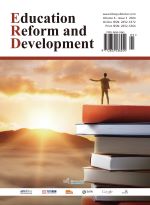Abstract
To solve the disjointed problems of teaching, research, and practice among schools, transportation planning departments, traffic management departments, and enterprises, a training model combining production, university, and research for transportation graduate students was established. The construction of a transportation engineering platform can provide a reference for the innovative training mode of engineering graduate students, and also provide ideas and means for the combination of production, study, and research of other majors. Under the operation of the scientific mode, it can achieve the goal of teaching and learning and the win-win situation of the school and enterprise to realize the effect of “one plus one is greater than two.”
References
Li JX, 2023, Using “Number” to Help the “Wisdom” Theory of Road Traffic Safety. Road Traffic Management, 2023(8): 86–87.
Zhong ZF, Nie P, 2016, Exploration on Training Mode of Transportation Professionals based on CDIO Concept. Human Resources Development, 2016(23): 1003–1073.
Zhu Q, 2010, The Cooperation Experience of Japanese Government, Industry, and University. China Science and Technology Industry, 2010(11): 72–73.
Shi YC, 2017, British Young Entrepreneurs Program to Cultivate “Business-Minded Scientists”. Shanghai Education, 2017(17): 52–53.
Sun Y, 2020, Construction and Enlightenment of Canadian University Entrepreneurship Education Ecosystem. Quality and Market, 2020(22): 124–126.
Wu W, Gong X, Liu XY, et al., 2023, Practice of Cultivating Innovation Ability of Transportation Professionals from the Perspective of “Industry-university-research-innovation”. Journal of Wuhan Polytechnic of Shipping, 22(1): 73–76.
He SK, 2023, Analysis on Development Difficulties and Strengthening Measures of “Industry-University-research Application” of Post-doctoral Workstation in Transportation Industry. Fujian Transportation Science and Technology, 2023(6): 86–88.
Zhang CG, 2021, Analysis of Joint Innovation Model and Achievements of Industry, University and Research in Urban Rail Transit. Modern Urban Rail Transit, 2021(6): 113–117.
Feng FL, Zhang JQ, 2020, Exploration of the Integration Mode of Industry-University-research and Application-business in Rail Transit Universities under the Background of new Engineering. Education and Teaching Forum, 2020(42): 174–176.
Miao XD, 2023, Integration of Production, Learning, and Research to Cultivate Outstanding Engineers of New Energy Vehicles. Times Automobile, 2023(20): 55–57.
Liu WX, Xue Y, 2023, Research on the Application of BIM Technology in the Teaching Reform of Landscape Engineering. China Educational Technology Equipment, 2023(7): 29–31.
Luo Y, 2000, How to Spend the “Running-in period” for College and Secondary School Graduates. Employment of Chinese College Students, 2000(10): 1–3.
Lai LH, 2024, Research on Priority Development Strategy of Urban Public Transportation in China, thesis, Fujian Normal University.
Jiang R, Jiang YY, Jiang DG, 2021, Research on Training Model of Skilled Digital Creative Talents under the Background of Industry-University-Research Cooperation: A Case Study of School-Enterprise Cooperation Platform Construction. Science Consulting (Science and Technology Management), 2021(8): 1–3.
Sun Y, 2019, Research on the Topic Selection of Master’s Degree Thesis of Higher Education in China in recent Ten Years, thesis, Southwest University.
Liu WW, Dong JS, 2016, Exploration and Practice of “Industry-University-Research” Cooperative Training Mode for Postgraduates: A Case Study of Transportation Engineering Major in Shanghai University of Science and Technology. Journal of University of Shanghai for Science and Technology (Social Science Edition), 38(03): 276–280.
